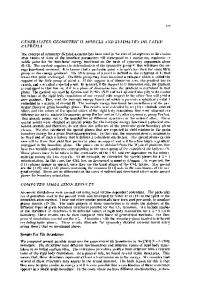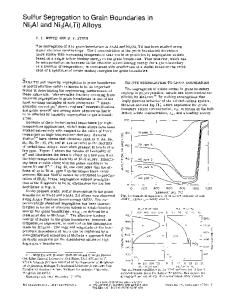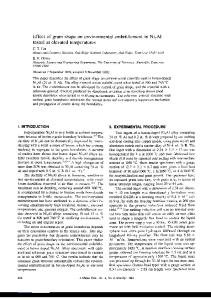Effect of boron on the mechanism of strain transfer across grain boundaries in Ni 3 Al
- PDF / 1,958,813 Bytes
- 5 Pages / 595.44 x 841.68 pts Page_size
- 57 Downloads / 416 Views
I. INTRODUCTION Ordered intermetallic compounds having the Ll 2 structure (for example, Ni 3 Al') have potentially desirable properties for high-temperature structural applications but their use has been precluded by the inherent intergranular brittleness of the polycrystalline material. 23 Recent work4 has shown that this problem can be ameliorated in Ni3Al by the addition of small amounts of boron, and tensile elongations of up to 50% have been obtained.5 The improvement in ductility is dependent on deviation from stoichiometry, optimum results being obtained for Ni-rich compositions.6 There is as yet no consensus as to the mechanism responsible for the boron-enhanced ductility. One suggestion6 is that boron improves the cohesive strength of grain boundaries. It would appear that the boundaries are intrinsically weak in the absence of boron, since brittle intergranular failure remains a problem even in highpurity Ni3Al.4 Computational studies7 indicate that the cohesive energy of the grain boundaries is indeed low when compared to the very high yield stress of Ni3Al. The segregation behavior of boron also supports the suggestion that boron enhances boundary cohesion, since it has been postulated6 that elements that segregate preferentially to grain boundaries will increase boundary cohesion while those that segregate preferentially to free surfaces will decrease it. Boron segregates strongly to the grain boundaries in Ni3Al but not to cavity (or free) surfaces; sulfur, which is an embrittling species, shows the opposite behavior.6 An alternative suggestion8'9 is that boron facilitates dislocation motion within the plane of a grain boundary, thereby easing the accommodation of strain resulting 436
J. Mater. Res. 2 (4), Jul/Aug 1987
http://journals.cambridge.org
from dislocation pileups at the boundary and lowering the stress intensity required for transfer of slip from one grain to the next. It is assumed in this hypothesis that dislocations are injected into the grain boundary from one grain and then emerge into the second grain leaving behind additional boundary dislocations. These boundary dislocations must move within the boundary if further slip dislocations are to cross the boundary at the same point. In support of this model, Schulson and coworkers9 have shown dislocations that appear to have reoriented as they entered a grain boundary at the tip of a pileup, with grain-boundary partial dislocations present nearby. As further evidence for this model, they cite the boron-induced reduction in the flow stress in finegrained samples. This effect can be understood from the Hall-Petch relationship between the flow stress ay and the grain size d: In this equation a0 is the stress opposing dislocation motion within a grain and n is a constant. Schulson et al.9 interpret k as varying with the degree of difficulty in dispersing strain at the head of a dislocation pileup. The reduction in flow stress in fine-grained material is then attributed to boron reducing k. The evidence for both models is indirect. The prese
Data Loading...











